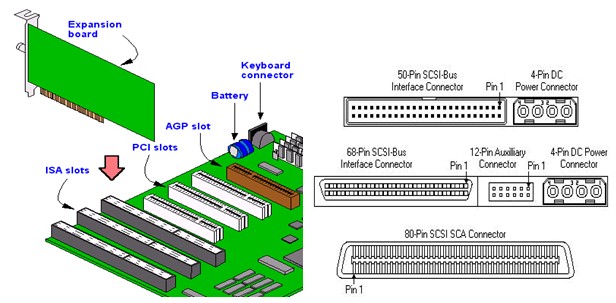It is a circuit board which increase the facilities provided by PC. They are of different kinds, but must match the bus type on the motherboard to install like, PCI network card can be installed only into a PCI expansion slot. Most common expansion cards are as follows
- Video card
- Network interface card (NIC)
- Modem
- Sound card
- I/O card
Video Card
A video adapter or a video card is the expansion card used in PC to display information on monitor or LCD. It converts the data from CPU into pixels to be suitable for display. They have dedicated chips to accelerating the speed of display. Most video cards are AGP and PCIe.
Network Interface Card (NIC)
It connects PC to a network for communicating with other computers on that network by translating the parallel data of PC into the serial data required by transmitting medium of network. It comes in different connector for different expansion bus on motherboard (PCI, ISA) and as per the connector of network (such as RJ-45 for UTP or BNC for coax). Software driver is needed to be installed on PC to use the network. Currently, NIC is integrated into motherboards so, no NIC card needed. Servers have more than one NIC (on-board or expansion slot) for load balancing or fault-tolerance applications.
Modem Card or Soft modem
Modem (Modulator/Demodulator) were used in older computer to connect them to Internet using a dial-up connection. A modem converts digital signals of a PC into analog signals that are transmitted over telephone lines and back again.
Modem Card also called soft modem is a modem with low capacities and to use a Pc’s resources to perform most of the tasks of a traditional modem. It is also called Winmodem because the first soft modems worked only with the Microsoft Windows. These expansion card are available for different slots (PCI,ISA) and they connect to the telephone line and provide another RJ-11 or telephone port for connecting to telephone.
Sound Card
A sound card also called audio card, is an internal computer expansion card that facilitates the input and output of audio signals to and from a computer under control of computer programs. Many different manufacturers make sound cards, like Creative Labs.
They have digital-to-analog converter (DAC), to convert computer’s digital data into an analog sound format and analog-to-digital converter for converting analog sound input to computer’s digital format. The output signal is connected to amplifier, headphones, or speaker and input signal is connected to microphone or mic.
It has small, round, 1/8-inch jacks on the back of it for connecting to microphones, headphones, and speakers as well as other sound equipment. Many sound cards also have a DA15 game port, which are used for either joysticks or MIDI connections (to connect PC to a digital musical instrument, like digital keyboard). They may also have an RCA jack for digital audio specification known as the Sony/Philips Digital Interface (S/PDIF).
I/O Card
They refer to circuit boards attached for input or output of data from devices. Common examples of I/O are serial and parallel ports in PC, disk drive interface connections, and so on.
SCSI interface cards were required for connecting to SCSI devices by conversion of the drive signals to those that the motherboard and the circuits installed on it could use. Multiple SCSI devices upto 15 can be connected on same cable and gave data rates up to 80Mbps. SCSI had many versions SCSI-1, SCSI-2, Wide, Ultra wide SCSI.
Today, common I/O adapter cards are USB 2.0 adapters and FireWire adapters.

Apply for IT Support Certification
https://www.vskills.in/certification/certified-it-support-professional

